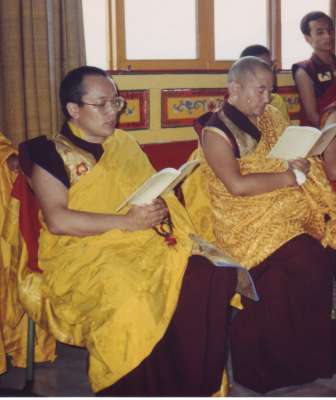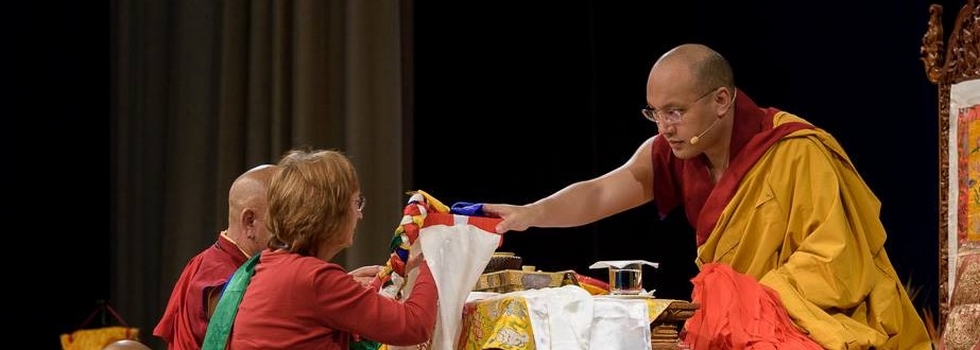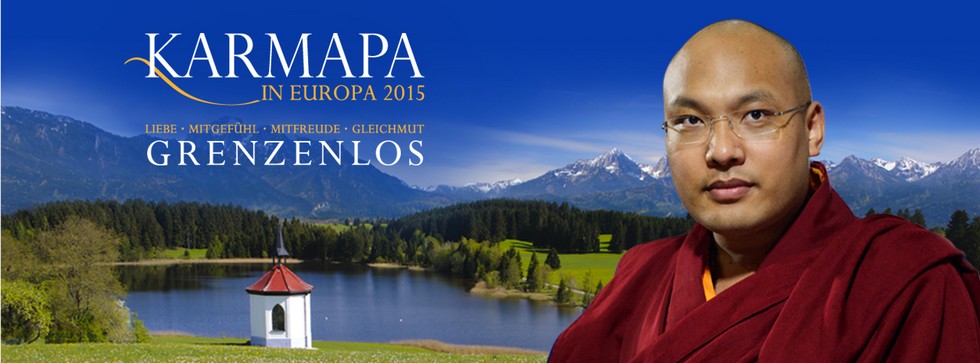
The Prajna Paramita
Introduction
At the request of the Dharma Center I am going to speak about what is called prajna paramita in Sanskrit, shes-rab-kyi-pha-rol-tu-phyin-pa in Tibetan. By looking at the Tibetan sentence, I think we can understand roughly what this subject means. Many times when we say "prajna paramita" most people think we are referring to emptiness. Of course, there is a connection - all dharmas have connections. There is a connection between shes-rab-kyi-pha-rol-tu-phyin-pa and emptiness, but emptiness is only one aspect of this subject. In the sentence, shes-rab-kyi-pha-rol-tu-phyin-pa, shes-rab is one word. Pha-rol and phyin-pa are other words, and kyi and tu are grammatical particles. The whole sentence describes the Mahayana aspect of Lord Buddha's teachings, the essence of the Mahayana teachings of Lord Buddha.
Shes-pa means knowing, knowledge,' rab means the best, the most profound, the most accurate,' so shes-rab means the best and most accurate knowledge.' Pha-rol means other side, other shore.' I don't know the name of a river in Taipei, but if you are standing on one side of a river and point to the other bank of the river, it is its pha-rol, other shore.' This side of the river is tsu-rol and the other side is pha-rol. Phyin-pa means reached, got there, achieved, accomplished.' If somebody has reached the other side of the river, that is phyin-pa. These three words, shes-rab, pha-rol, and phyin-pa have these distinctive connotations. When we use the grammatical particles with them, the sentence becomes shes-rab-kyi-pha-rol-tu-phyin-pa. There are five types of the particle kyi in Tibetan grammar and they very much serve the same purpose as the English word of,' e.g., the children of such and such a person.' There are seven versions of the particle tu - su, ra, ru, and so forth - and they have the same meaning. Put simply, they mean something like to, at, of.' What do the two particles do to the three words? They bring the three words together to mean the best understanding, the most accurate understanding, reaching complete accomplishment, the other side of the river of perfect understanding.'
In this context, the word shes-rab has two meanings, an objective meaning and a subjective meaning. The subjective meaning of the best and most accurate understanding is wisdom-awareness. How and why would one have accurate understanding? Because of having wisdom-awareness. The objective meaning of shes-rab is accurate understanding, in this context, the complete accomplishment of wisdom-awareness.' So this is how the sentence shes-rab-kyi-pha-rol-tu-phyin-pa should be understood in Tibetan linguistic terms. It is the word for "Prajnaparamita." In English, what is translated as "The Heart Sutra" is the name of one Sutra, but there is much more to it. We have garnered an understanding of the term prajna paramita from the Tibetan phrase shes-rab-kyi-pha-rol-tu-phyin-pa.
In order to understand the word shes-rab more deeply, however, we need to understand the word ye-shes. We never say ye-shes-kyi-pha-rol-tu-phyin-pa nor do we call a particular Sutra by this name, but when we learn about the ten paramitas, the sixth - the prajna paramita - is elaborated into four, one of them being yes-shes (jnana in Sanskrit). The six paramitas are: generosity, ethics, diligence, patience, meditative concentration, and wisdom-awareness (prajna). The ten paramitas are these six plus skilful means, aspiration, strength, and primordial wisdom (ye-shes). When we speak of the six paramitas, the last is shes-rab, but when we speak of the ten paramitas, the sixth of shes-rab, wisdom-awareness,' has four more details, which added together make ten. From this point of view, the last of all ten paramitas is ye-shes. Ye-shes is shes-rab, but when we learn about it, we should know what these words mean separately.
There is a similarity between the words shes-rab and ye-shes - the shes. In shes-rab, the shes is at the beginning of the word; in ye-shes it is at the end. In ye-shes, shes is the abbreviation of shes-rab and ye is the abbreviation of ye-ba, which means forever' or existent since beginningless time.' This is translated beautifully into English as primordial wisdom.' Wisdom' is shes and ye is primordial,' so ye-shes means primordial wisdom.' By understanding this, we understand that shes-rab does not only mean intelligence, the ability to know something,' but it also means the potential for wisdom, the essence of wisdom.' When we say shes-rab-kyi-pha-rol-tu-phyin-pa, we understand that all of this is included.
The Buddha taught the paramita of prajna on all levels, but particularly at the Second Turning of the Wheel of Dharma. The First Turning of the Wheel of Dharma began at Varanasi. On that occasion, the Buddha taught about the Four Noble Truths and so forth. Superficially speaking, these are the Hinayana aspects of the teachings, but in truth Buddha's teachings cannot be restricted through designations. The Second Turning of the Wheel of Dharma began at Rajgir and the teachings are considered Mahayana. But truly speaking, the Buddha did not teach - he manifests the Dharma. The Buddha is not like you and me - we have to think, plan, do homework, and then talk. But the Buddha manifests the Dharma. The Buddha did not teach in a dualistic manner - the Dharma is part of him - it is his limitless activity. Disciples heard Lord Buddha teach in a dualistic manner and in reliance on their individualities, but Buddha manifests the Dharma without any limitations whatsoever. When we speak about the First and Second Turnings of the Wheel of Dharma, we are speaking from a dualistic point of view, from a historical and superficial perspective.
The Second Turning of the Wheel of Dharma deals with the teachings entitled "The Prajnaparamita Teachings." The "Prajnaparamita Sutras" are extensive. There are 17 main texts and "The Heart Sutra" is one of them. It is actually the smallest in length. The longest version consists of 100,000 slokas. One sloka has 4 sentences, so 100,000 slokas make 400,000 sentences. The second longest version consists of 20,000 slokas; the third of 8,000 slokas. One of the shortest is "The Heart Sutra," which we call "Shes-rab-nying-po" in Tibetan. Shes-rab means wisdom-awareness' and nying-po means essence,' so the title of the text is "The essence of Wisdom-awareness." The Tibetan word nying also means heart,' the one we have that pumps the blood. But nying in this context does not mean heart,' rather it means essence.' So shes-rab-nying-po means the essence of wisdom-awareness.'
Not all Sutras are expositions of prajna paramita. There are many different Sutras. It's very interesting that whenever people read a Buddhist text these days, other people say, "This Buddhist is reading a Sutra." Maybe he is reading a Sutra; maybe he is reading a Tantra. Maybe he is reading a Vinaya or an Abhidharma text. Maybe he is reading a history book. He may even be reading a prayer, which is not Sutra or Tantra but was written by some master. It's hard to know, but still people call everything "Sutra." There's nothing wrong with this, but it's not accurate. If you want to be precise, it's not precise speaking in this way.
Within the Sutras, "The Prajnaparamita Sutras" are paramount, mainly because there are 17 such texts. Most of them aren't long, but some of them are very long and big texts that consist of many volumes. For this reason, the title "Prajnaparamita" is given to a group of Sutras that contain a very important aspect of the Buddha's teachings. These teachings are very much involved with emptiness, therefore we think about emptiness when we hear about "The Prajnaparamita."
Nying-po is a very interesting word in the Tibetan language. I will give you an easy example: When somebody talks about all kinds of things and goes around in circles, trying to tell you something, then you will respond, "Please tell me the nying-po of the subject." What you are really saying is "Don't talk in circles. Don't try to elaborate things too much and be too polite or too complicated. Just tell me what it is you want to say." We use the word nying-po then. It's also used in other ways. In medicine, the word nying-po is also used. Most medicine consists of many things. The specific, un-mixed ingredient doesn't have much power; you might need a kilo to get a beneficial result. But when the essence, the nying-po, is distilled into one drop, it can have the benefit of one kilo. This way, the medicine contains the nying-po of that ingredient. So nying-po is a very useful, nice, and easy word. I wanted to share this because I think it will be useful in many ways for those of you who are learning Tibetan.
The word nying-po is also used to describe the Buddha nature. bDe-bar-gshegs-pa'i-snying-po or sangs-rgyäs-ki-nying-po are the Tibetan terms for Buddha nature.' bDe-bar-gshegs-pa'i-nying-po (Sugata in Sanskrit) is another name for Buddha. Sangs-rgyäs also means Buddha.' There are many words for "Buddha." Nying-po, again, means essence.' In this way, the word nying-po plays a very important role in describing the Buddha nature or the Buddha essence.
I think the name, background, and Sutras have been addressed enough for the time being. I will now briefly explain the definition of emptiness according to the teachings in "The Prajnaparamita Sutras."
A Brief Definition of Shunyata
When Lord Buddha taught "The Prajnaparamita Sutras," he mentioned shunyata in each of the 17 versions. The Sanskrit term is popularly translated as emptiness.' I do not have a better word, but I don't like the word emptiness' because it usually designates a pretty bad feeling, like "I feel empty." I'm sure there must be a better word in English, but we are pretty lazy. If someone finds a word and everybody is happy with it, we just go along and don't bother fixing it. Somebody will fix it in the future, but for the time being it's okay as a working basis. So, shunyata ( emptiness' in English) is stong-pa-nyid in Tibetan. Buddha emphasized shunyata in all 17 versions of "The Prajnaparamita Sutras" in many different ways.
sTong-pa-nyid pervades everything we see, hear, touch, etc. It also pervades our mind that sees things through the eyes, hears things through the ears, touches things through the body, etc. This is all nothing more or less than the interdependent manifestation of one's apperceptions. That is the basic definition of shunyata. Buddha did not mean that the things we see over there are not there. He is not saying that our eyes are not here or that our mind is not here. He just said that everything we see or hear is nothing more than a manifestation of interdependence. That is what emptiness or shunyata means when put in a simple context.
Sometimes when we are in the middle of seeing, hearing, smelling, tasting, and touching, it seems to us that this topic is a hard to understand. If you see from the perspective of Lord Buddha's teachings, however, the teachings on the paramita of prajna are very simple and easy to understand. With "The Prajnaparamita Teachings" in mind, it's almost impossible not to understand shunyata. I will give you an example.
Think of three people you know. The first is a neurotic person. He or she is someone who makes a big deal about anything, someone who gets upset over smallest things. I'm sure you know somebody like this; all of us know someone who is very neurotic. I know somebody who is neurotic. The person you know does not need to be the person I know, though. I think each one of us knows someone like this. Think of this person. Then think of someone who is not neurotic, a very practical, clear, mature individual; not spiritually developed, not wise, not enlightened, but just down-to-earth and level-headed. Think of this person too. Then think of a person you think is very mature, highly developed, a spiritual person. Sometimes in Asia when I say "spiritual" people think I am referring to ghosts. I'm not talking about ghosts, rather about religious masters. Since we are all Buddhists, let us say this person is a Buddhist practitioner, an advanced person who we revere and respect. Imagine these three types of people. I'm not saying to visualize them, just think of them.
For the neurotic person, everything is a big deal, anything can go wrong at any time. For example, if you look at this person, they will ask, "What are you looking at?" If you do not look at this person, they will say, "You don't even look at me. Do you think I'm a beggar?" If you do not give this person anything, he will probably remark, "You don't appreciate me." These are a few examples, but you can add more. That is the neurotic person's perception; it is reality for a neurotic person.
For the down-to-earth person, however, life is not like that. When someone looks at him or her, they do not ask, "Why?" They think maybe this person is saying, "Hello." Maybe they are just looking. Maybe they are looking to see if that person is doing something wrong. It depends. This person does not have the attitude that everything seems to go wrong all the time. Wrong things are wrong and right things are right and clear for him or her. Such people still have attachment, jealousy, anger, ignorance, pride, and all the other negative emotions, but they are not neurotic. Everything is fine and makes sense to them. They are not mixed up or crazy. That is a second kind of reality.
For the quite advanced person there is much less attachment, anger, jealousy, pride, and other similar problems as for the second type. Of course, when somebody is mean to this person, he or she will not like it - nobody likes it when others are not nice. But they will be able so say, "I'm not going to react to this. I'm not going to make bad things worse. I'll take this as purification. I must have some kind of karma with this person. Let this be the debt that I am repaying. I have some debt that is now being repaid, so I'm grateful to be relieved of this debt." He or she will be able to think like this. If somebody tries to irritate and make them angry, they will be able to say, "This person is really bothering me. This person is really irritating me. It's more than too much, but still if nobody does this, how will I be able to practice patience? This person is a teacher in disguise. Perhaps he isn't intentionally trying to teach me Dharma, but for me it works like that." This is how an advanced person's reality would be like. When we look at the reality of these three types of people, the definition of shunyata is very clear and right there.
The way we can understand emptiness through this example is very simple. Everything is experienced differently for these three types of people, yet everything is the same. These three types of people can be in the same room while having three different reactions to anything around them. Which one is true? Which one isn't true? Of course, we like to say, "The spiritual person's reality is true and the others' reality isn't." We can say this, but it isn't true for the neurotic person. He will cry, laugh, and do astonishing and terrible things in reliance on his or her propensities. All of this occurs because of shunyata. If there were no such thing as shunyata, then there would be one reality for everyone. In fact, reality doesn't even stay static for one person during the course of a day. If you were to enter a room in which ten people were doing exactly the same thing at 10 o'clock in the morning, sit there for an hour and then leave, you would have an experience. If you were to return there after lunch and sit for another hour before going out again, you would have another experience. Should you return in the evening, sit for another hour and leave again, you would have another experience. You will have three different responses to your experiences, not necessarily totally different, but definitely slightly different. In this way, things are not the same for one person during an entire day, let alone for ten people, because of shunyata. Everything is an interdependent manifestation of everything else, nothing more and nothing less. This is the simple definition of shunyata. There are, of course, much more philosophical definitions, but they might be a bit too complicating for now and not as useful in everyday life. They are useful for philosophers. Many people get Ph.D.s by debating the topic of shunyata.
To end this discussion, I want to share with you one of the words commonly used in the Kagyü Lineage - gzhän-stong. The Tibetan term gzhän-stong describes emptiness according to our lineage. gZhän means other,' and an abbreviated way of saying stong-pa-nyid is stong. What does it mean? Well, it means everything has a limitless essence, an essence not limited by anything. Everything and everyone has a limitless potential, a limitless essence. Also, nothing has a solid, dualistic existence that is restrictive. Everyone and everything is the embodiment of the limitless potential, the limitless essence. That is what gzhän-stong means. I will try to summarize this once more.
Nothing and nobody has a dualistic and limited existence. You can say "reality" if the word "existence" is difficult. Everything and everyone is free of a dualistic and limited reality. The essence of everything and everyone is limitless and non-dualistic. This is the definition of gzhän-stong, gzhän meaning other.' "Other" means limited, dualistic,' so gzhän-stong means devoid of what is other (than the essence).' We do not say, "This flower is not here," and I will never say, "I am not here." You can never say that your mind is not here. You can never say that your body is not here. But you can say, "My mind of attachment, anger, jealousy, and everything like that is not it. Those emotions are interdependent manifestations that depend upon conditions and arise due to my karma. In reality, my mind is buddha." When you recognize that you have a jealous, carving, greedy, and arrogant mind, it is true, but it's not the total sum of your being. It's only one manifestation of your limitlessness. You are buddha, you are limitless, and you are non-dual. That is what gzhän-stong means.
When we don't say gzhän-stong but only "emptiness," there is the possibility we will misunderstand and think nothing is there. If nothing is here, then nothing is there, and there are no big problems and nothing matters. If nothing is here, who will become a buddha? What are we doing here? Why do we meditate? Why do we try to attain buddhahood? If there is nothing, there is no reason to do anything except to go about and have a good time. This way, the definition of emptiness through the usage of the term zghän-stong makes it every clear that the essence of everyone is not nothing - it is limitless, it is buddha. The essence of the environment is not nothing - it is limitless, it is the buddha fields, the mandala of the buddha fields. I hope this idea of emptiness (shunyata, stong-pa-nyid) is meaningful for you. Now I will briefly explain the connection between shes-rab (prajna in Sanskrit) and ye-shes, the paramitas of full accomplishment or realization of shunyata.
Shes-rab and Ye-shes
The linguistic definition of shes-rab is intelligence which enables one to have an accurate understanding.' From this point of view, when one is intelligent, one thinks very clearly and examines everything very precisely, i.e., one breaks things down. One breaks solid things down to atoms and tiny particles. One breaks down time into hours, minutes, seconds. Or one breaks down the concept one has of one's self into defilements and all the different mental factors, attitudes, and psychological particularities that one has. If one does this, then one will see very clearly that everything is nothing more and nothing less than a manifestation that arises in dependence on other things. There is no such thing as "a long time" or "a short time" if one looks into it. There is no such thing as "a big thing" or "a little thing" if one really looks into it. It's all superficial - it's all relative. Knowing this is shes-rab, which is the result of clear thinking that comes from seeing clearly. This is an intellectual description of the connection between shes-rab and emptiness or shunyata. When one knows the truth, when one sees the truth, then the truth is shunyata.
The words shes-rab and ye-shes have different meanings, but ye-shes includes shes-rab. In this context, ye-shes means primordial wisdom' and shes-rab is the more intellectual aspect of primordial wisdom. Wisdom is only possible because of shunyata, i.e., if things are limited and divided, then there can be no wisdom. If everything is limited and dualistic, the world would just be a school where someone teaches and others learn. There would only be knowledge and no wisdom. Knowledge is superficial - it's good, but it's superficial, dualistic, and doesn't lead to deepest insight. It's only information received from the outside, like putting on nice clothes. We learn about this, we learn about that, we learn so much and put it all in our heads, and by the time we learn everything, we begin to forget. We end up with diplomas and certificates that confirm that we learned specific things. This is knowledge and it doesn't bring transformation. For example, a knowledgeable person and a person who received no education can both become angry and act badly. Sometimes an educated person will act worse than someone who isn't educated; sometimes he will act better. Reactions depend upon other things. They have nothing to do with knowledge, but point to someone's deeper aspects. In this way, knowledge is good, but it isn't wisdom. Wisdom comes from within.
Wisdom is possible because of shunyata, because of gzhän-stong, because we have the primordial, ever-present, all-pervading, limitless potential within. It is awakened by generating and developing a wholesome attitude, devotion, as well as love and compassion and by engaging in purification and meditation practices. This is the meaning of shunyata and gzhän-stong - the limitless, non-dual potential of all sentient beings. It is why wisdom arises from within.
So, this is the connection between wisdom and emptiness. We are able to appreciate and acknowledge the definitions of shunyata, the paramita of prajna ( wisdom-awareness') and the paramita of ye-shes ( primordial wisdom'). No matter which definition, shunyata and prajna paramita can be seen from two sides. One side is academic and intellectual. It is knowledge, but it doesn't do anything - we know that everything is shunyata and that's it. The other side is the perspective of primordial wisdom where through realizing shunyata from within, we become enlightened, we become a buddha, and this is the purpose of Lord Buddha's teachings on the paramita of prajna. We can see its intellectual aspect as well as its ultimate aspect. By gaining understanding, I think we can have a more comprehensive and beneficial understanding of prajna paramita.
Conclusion
I will close my talk here and sincerely hope and pray that what I shared with you here is beneficial for you. I try to remember what I have learned from my very noble and kind masters and try to share what I learned as clearly and accurately as possible. I don't think that I made any mistakes, but if so, then it's a serious matter and I confess to the Buddhas, Bodhisattvas, and masters. Prajna paramita is a vast, deep, and subtle topic that can't be fully covered in a short talk like this.
One thing we should always remember is that whatever I have been able to share with you here is available and accessible because of the lineage. Lord Buddha's teachings have continued from master to disciples up to the present day. This means nobody has to guess what the Buddha meant when he turned the Wheel of Dharma more than 2,500 years ago. If we had to guess, I'd give up. I wouldn't even try to interpret a word of the Buddha. I'd have to be enlightened first in order to be able to interpret the Buddha's words correctly. I would look for someone who has the lineage and I would not try by myself. In this way, the words of the Buddha have continued until today and their meaning has been transmitted to us. It is due to the greatness of all past lineage masters and of those who are living that we do not have to work hard to research. In Buddhism, we don't have to research anything - it's all there. We don't have to search anywhere - it's all available and is alive. We just have to receive the teachings and practice them. This is what enables me to share these teachings with you. Sharing them with you helps me recollect the meaning and receive the blessing of my masters again. In this way, I am very happy that we have been able to speak about this topic.
And now, my merit, the merit of everyone who listened, the merit of everyone who arranged this event, the merit of all individuals should be dedicated for the welfare of all sentient beings. They will receive the benefits of dedicating the merit because they all have the limitless potential that doesn't exclude any merit that has been accumulated and given to them. Thank you very much.

Dedication Prayers
Through this goodness may omniscience be attained
And thereby may every enemy (mental defilement) be overcome.
May beings be liberated from the ocean of samsara
That is troubled by waves of birth, old age, sickness, and death.
By this virtue may I quickly attain the state of Guru Buddha and then
Lead every being without exception to that very state!
May precious and supreme Bodhicitta that has not been generated now be so,
And may precious Bodhicitta that has already been never decline, but continuously increase!
A Long Life Prayer for His Eminence Khentin Tai Situ Rinpoche
The Regent of the Future Buddha, the Undefeatable,
The Regent of the Lotus, the protector of all beings and the teachings,
Tai Situ Pema Dönyo,
May your life be long and your activities be extensive.
Presented at the Karma Kagyü Center in Taipei in 1998. Transcribed in 1999, edited and arranged for students of the Download Project of Khenpo Karma Namgyal in 2009 by Gaby Hollmann. Sincere gratitude to Lee of Puli-Nantou for having provided the recording of these teachings. Photo of H.E. Tai Situ Rinpoche and H.E. Goshir Gyaltsab Rinpoche at Rumtek Monastery, Sikkim, in May 1992 taken by Gaby. Photo of flowers taken and kindly offered by Lena Fong. Copyright H.E. Tai Situ Rinpoche and Karma Lekshey Ling Institute in Nepal, 2009. All rights reserved. Distributed for personal use only.















